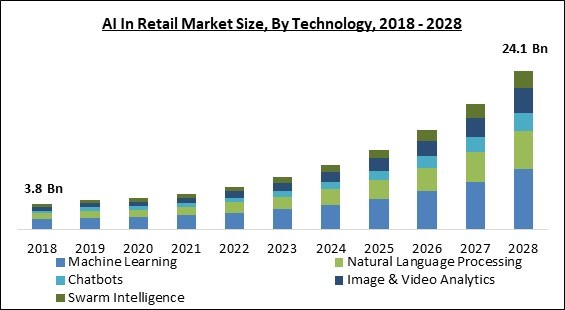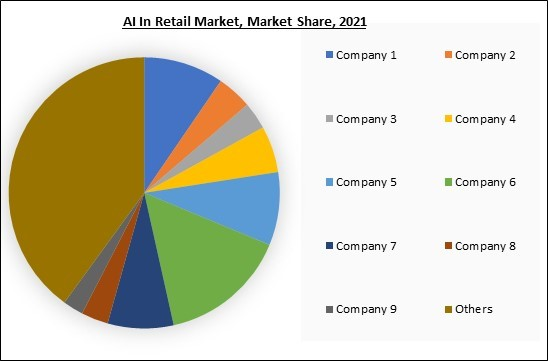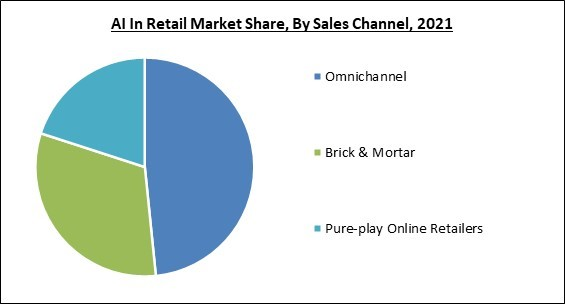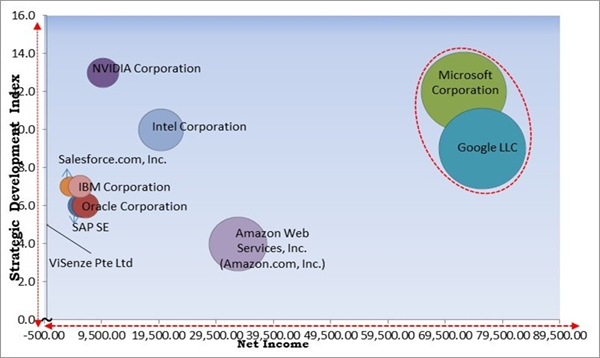Physical stores are still the leader in retail, but they must operate in very competitive markets. Similar to physical stores, digital stores compete in a market where they can easily access their rivals. Retailers can utilize AI to enhance the shopping experience for customers and acquire the competitive edge they need to remain relevant.
For instance, AI-powered virtual personal assistants and chatbots on a website provide customers personalized recommendations or dynamic pricing depending on their usage of the site, past purchases, and other pertinent information. Retail AI application cases exist in actual stores as well, utilizing data sources including in-store customer interactions via mobile devices and through sensors.
Using an algorithm that has been trained with sales data and other pertinent information, retail store owners can even utilize AI to optimize the layout of their stores. This aids in forecasting outcomes, such as a person's propensity to purchase two things simultaneously if they are exhibited near to one another. The retail industry is changing as a result of artificial intelligence (AI). Retailers can use AI to engage with their consumers and run more effectively, from utilizing computer vision to tailor promotions in real time to leveraging machine learning for managing inventory.
COVID-19 Impact Analysis
Due to the WFH policy brought on by this pandemic, the COVID-19 outbreak is anticipated to accelerate the market growth of next-generation tech fields, including artificial intelligence. In order to increase availability across the globe, tech companies are also increasing the range of products and services they offer. Therefore, the integration of AI significantly increased within the retail industry. Hence, the growth of the market was steadily hampered, however, the increased utilization of AI augmented the growth of AI in the retail industry.Market Growth Factors
Higher Efficiency In Saving Cost And Optimizing The Experience
AI comprises the ability to drastically change retailing in coming years, impacting everything from cost structures to the shopping experience. E-commerce and AI go hand in hand, and the coronavirus pandemic's acceleration of e-commerce growth rates makes AI adoption even more imperative. AI advantages will transform the industry. Retailers must therefore start making plans right away. And not just technology should be included in those plans, but also business strategy.Higher Supply Chain Capabilities
As a whole, one of the main advantages of artificial intelligence is that it can assist people with repetitive, time-consuming jobs. A significant number of workers believe that the increased adoption of AI in the workplace has improved productivity. And when AI is used in retail, the same thing may occur. Drivers in the logistics industry can use AI to discover the best delivery routes. Additionally, robots can assist with choosing and packing orders, freeing up staff members to work on other crucial activities.The leading players in the market are competing with diverse innovative offerings to remain competitive in the market. The below illustration shows the percentage of revenue shared by some of the leading companies in the market. The leading players of the market are adopting various strategies in order to cater demand coming from the different industries. The key developmental strategies in the market are Partnerships & Collaborations.
Market Restraining Factors
High Costs As Well As Lack Of The Ability To Improve
It is an impressive achievement when a machine can imitate human intelligence. However, the initial cost of AI is very high in such operations. It can be very expensive and takes a lot of time and resources. AI is highly expensive because it requires the newest software and hardware to function in order to stay updated and meet criteria. Artificial intelligence is a technology that cannot be created by humans since it is pre-programmed with knowledge and experience.Component Outlook
On the basis of Component, the AI in Retail Market is bifurcated into Solutions and Services. In 2021, the solution segment acquired the largest revenue share of The AI in retail market. The management issues facing a number of retail operations are encouraging the development of new automated technology. Retailers can manage warehouse management, supply chain operations, and logistics, and enhance the customer experience with the use of AI-powered solutions.Technology Outlook
Based on the Technology, the AI in Retail Market is segregated into Machine Learning, Natural Language Processing, Chatbots, Image and Video Analytics, and Swarm Intelligence. In 2021, the machine learning segment procured the highest revenue share of the AI in retail market. The growth of the segment is rising due to the higher precision and flexibility of this technology. Machine learning is appropriate for providing customers with individualized experiences because it serves data quickly and deeply.Sales Channel Outlook
By Sales Channel, the AI in Retail Market is segmented into Omnichannel, Brick and Mortar, and Pure-play Online Retailers. In 2021, the pure-play segment acquired a significant revenue share of the AI in retail market. The growing popularity of online and virtual shopping is expected to accelerate the development of pure-play internet merchants. AI, IoT, and social media would proliferate, which would lead to an expansion of the AI in retail market.Application Outlook
On the basis of Application, the AI in Retail Market is classified into Customer Relationship Management (CRM), Supply Chain and Logistics, Inventory Management, Product Optimization, In-Store Navigation, Payment and Pricing Analytics, and Virtual Assistant. In 2021, the customer relationship management (CRM) segment witnessed the largest revenue share of the Ai in retail market. A strong need to improve customer service and retention would propel the CRM industry to prominence. Retail suppliers may foster consumer loyalty and solid customer connections with the help of AI-powered virtual assistance, search engines, chatbots, and other technologies.Regional Outlook
Region-Wise, the AI in Retail Market is analyzed across North America, Europe, Asia-Pacific, and LAMEA. In 2021, North America accounted for the largest revenue share of the Ai in retail market. As considerable investments are made in AI projects along with related research and development initiatives, there is potential for industrial expansion. Regional retail suppliers are also focusing on extracting the available data on consumer preferences to increase the effectiveness of their customer care. The market leaders use both organic and inorganic techniques in order to grow.Cardinal Matrix-AI In Retail Market Competition Analysis
The major strategies followed by the market participants are Partnerships. Based on the Analysis presented in the Cardinal matrix; Microsoft Corporation and Google LLC are the forerunners in the AI In Retail Market. Companies such as Amazon Web Services, Inc. (Amazon.com, Inc.), Intel Corporation and NVIDIA Corporation are some of the key innovators in AI In Retail Market.
The market research report covers the analysis of key stake holders of the market. Key companies profiled in the report include Intel Corporation, Salesforce.com, Inc., NVIDIA Corporation, Amazon Web Services, Inc. (Amazon.com, Inc.), Google LLC, IBM Corporation, Microsoft Corporation, Oracle Corporation, SAP SE, and ViSenze Pte Ltd.
Strategies deployed in AI In Retail Market
Partnerships, Collaborations and Agreements:
- Sep-2022: Microsoft partnered with Infosys, an Indian multinational information technology company. Through this partnership, the companies aimed to enable businesses to swiftly redefine customer experiences, amplify systems with cloud and data, and renew processes.
- Jun-2022: NVIDIA came into a partnership with Siemens, a German multinational conglomerate. Through this partnership, the companies aimed to integrate Siemens Xcelerator and NVIDIA Omniverse in order to offer an industrial metaverse along with physics-based digital models.
- Jun-2022: Google entered into a partnership with the H&M Group, a global fashion retailer. Through this partnership, the companies aimed to design and develop an enterprise data backbone encompassing a core data platform, advanced AI and ML capabilities, and data products.
- Jun-2022: Oracle joined hands with Komax, a retail group. Following this collaboration, Oracle would offer its Retail suite of services over its cloud infrastructure to Komax in order to help the business in introducing the latest clothing, accessories, and shoes from a range of popular brands to customers across Latin America.
- Apr-2022: SAP entered into a partnership with Kyndryl, a leading IT infrastructure services provider. With this partnership, the companies aimed to focus on bringing novel solutions to address the most complex digital business transformation challenges of customers.
- Mar-2022: NVIDIA teamed up with Kroger, an American retail company. With this collaboration, the companies aimed to improve the shopping experience for customers through AI-enabled services and applications.
- Mar-2022: Microsoft came into an agreement with ASOS, a British fashion retailer. With this agreement, the companies aimed to jointly work on a new project intending to expedite their strategic growth plans of Microsoft. Moreover, this partnership would also allow companies to meet the rising demand for better product availability along with personalized and seamless digital experiences.
- Feb-2022: AWS partnered with Kyndryl, an American multinational information technology infrastructure services provider. Following this partnership, the companies aimed to establish a Cloud Center of Excellence in order to develop joint solutions, including mission-critical infrastructure services, mainframe services, and network and edge computing services.
- Jan-2022: Microsoft joined hands with Tata Consultancy Services, an Indian multinational information technology services and consulting company. This collaboration aimed to develop and commercialize the newly launched Microsoft Cloud. furthermore, the new solution aimed to aid customers in expediting their transformation and growth journey.
- Jan-2022: Google came into a partnership with NCR Corporation, an American software, consulting, and technology company. Following this partnership, the companies aimed to develop an additional platform along with new capabilities, such as AI and ML. This partnership aimed to offer access to best-in-class tools along with seamless flexibility to retailers in order to provide enhanced in-store experiences for consumers.
- Sep-2021: Microsoft expanded its partnership with Honor, a smartphone brand. Under this expanded partnership, Honor would leverage AI translation as well as AI speech built or on Microsoft Azure. In addition, these services would support Honor's YOYO Smart Assistant.
- Jul-2021: Google expanded its partnership with Home Depot, an American multinational home improvement retail corporation. Through this expanded partnership, the companies aimed to advance digital transformation among retailers while also providing enhanced shopping experiences to customers.
- Jun-2021: Salesforce came into a partnership with AWS, a subsidiary of Amazon. This partnership aimed to streamline it for customers to leverage the complete range of the capabilities of AWS and Salesforce in order to build and deploy robust new business applications quickly.
- Apr-2021: NVIDIA collaborated with Cloudera, an American software company. Following this collaboration, the companies aimed to expedite AI and Data Analytics in the Cloud with a new software that allows businesses to accelerate data pipelines and also expand the performance boundaries of data and machine learning.
- Dec-2020: Salesforce teamed up with Yes Bank, an Indian bank. Under this collaboration, Yes Bank would offer personalized and smart customer experiences by leveraging the Salesforce platform to engage customers with a unified experience.
- Mar-2020: ViSenze collaborated with Pixibo, a fashion tech company. Under this acquisition, ViSenze would integrate its AI-powered visual commerce capabilities into Pixibo's fit and size recommendation platform in order to offer suitable goods on the basis of the preferences of the customer.
Product Launches and Product Expansions:
- Aug-2022: ViSenze launched ViSenze’s Session-Based Recommendations, a new personalized e-commerce product recommendations solution. The new solution aimed to offer a more customized experience to customers without the requirement for gathering personal data.
- Jul-2022: Intel released a set of reference kits. The new solution aimed to allow data developers and data scientists to learn the faster and more convenient deployment of AI within manufacturing, retail, healthcare, and other environments.
- Jun-2022: Salesforce rolled out the Sales Cloud Unlimited, a unified platform. With this launch, the company aimed to propel its growth and also turn sales reps into reliable advisors.
- Jun-2021: NVIDIA rolled out the NVIDIA AI LaunchPad, a hybrid-cloud providers-delivered comprehensive program. The new solution aimed to offer immediate access to enterprises to NVIDIA-powered software and infrastructure with the aim to facilitate the entire AI lifecycle.
- Apr-2021: IBM introduced new capabilities for IBM Watson. With this product expansion, the companies aimed to integrate Time Series capabilities within IBM Watson Studio in beta to address challenges in automating, forecasting, and analyzing time series data.
- Apr-2021: Intel launched the new third Gen Intel Xeon Scalable processor, its most advanced artificial intelligence-based data center platform. The new solution aimed to offer a substantial spike in performance in contrast to the older generation.
- Jan-2021: Google unveiled a new range of retail AI products. Through this launch, the company aimed to increase its focus on reaching new industry verticals. The new product range is developed for large as well as small businesses in order to allow retailers to offer highly personalized product recommendations to their customers.
Mergers & Acquisition:
- Jul-2022: SAP took over Askdata, a search-driven analytics startup. Following this acquisition, the company aimed to expand its ability to aid businesses in making well-informed decisions through AI-driven natural language searches.
- Mar-2022: Microsoft took over Nuance Communications, an American multinational computer software technology corporation. Following this acquisition, the company aimed to integrate the best-in-class conversational AI and ambient intelligence of Nuance into its trusted and secure industry cloud offerings.
- Feb-2022: IBM completed its acquisition of Neudesic, a leader in cloud services. Following this acquisition, the company aimed to expand its hybrid multi-cloud services offerings along with accelerating its AI and hybrid cloud strategy.
- Jan-2022: Oracle acquired Federos, an IT Services and IT Consulting company. This acquisition aimed to empower service providers through AI-optimized service as well as network analytics, assurance, and automated orchestration.
- Apr-2020: NVIDIA acquired Mellanox Technologies, an Israeli-American multinational supplier of computer networking products. With this acquisition, the company aimed to allow customers to experience higher performance, lower operating costs, and increased utilization of computing resources.
Scope of the Study
Market Segments Covered in the Report:
By Technology
- Machine Learning
- Natural Language Processing
- Chatbots
- Image & Video Analytics
- Swarm Intelligence
By Sales Channel
- Omnichannel
- Brick & Mortar
- Pure-play Online Retailers
By Component
- Solution
- Services
By Application
- Customer Relationship Management (CRM)
- Supply Chain & Logistics
- Inventory Management
- Product Optimization
- In-Store Navigation
- Payment & Pricing Analytics
- Virtual Assistant
By Geography
- North America
- US
- Canada
- Mexico
- Rest of North America
- Europe
- Germany
- UK
- France
- Russia
- Spain
- Italy
- Rest of Europe
- Asia Pacific
- China
- Japan
- India
- South Korea
- Singapore
- Malaysia
- Rest of Asia Pacific
- LAMEA
- Brazil
- Argentina
- UAE
- Saudi Arabia
- South Africa
- Nigeria
- Rest of LAMEA
Key Market Players
List of Companies Profiled in the Report:
- Intel Corporation
- Salesforce.com, Inc.
- NVIDIA Corporation
- Amazon Web Services, Inc. (Amazon.com, Inc.)
- Google LLC
- IBM Corporation
- Microsoft Corporation
- Oracle Corporation
- SAP SE
- ViSenze Pte Ltd
Unique Offerings from the Publisher
- Exhaustive coverage
- The highest number of Market tables and figures
- Subscription-based model available
- Guaranteed best price
- Assured post sales research support with 10% customization free
Table of Contents
Companies Mentioned
- Intel Corporation
- Salesforce.com, Inc.
- NVIDIA Corporation
- Amazon Web Services, Inc. (Amazon.com, Inc.)
- Google LLC
- IBM Corporation
- Microsoft Corporation
- Oracle Corporation
- SAP SE
- ViSenze Pte Ltd












